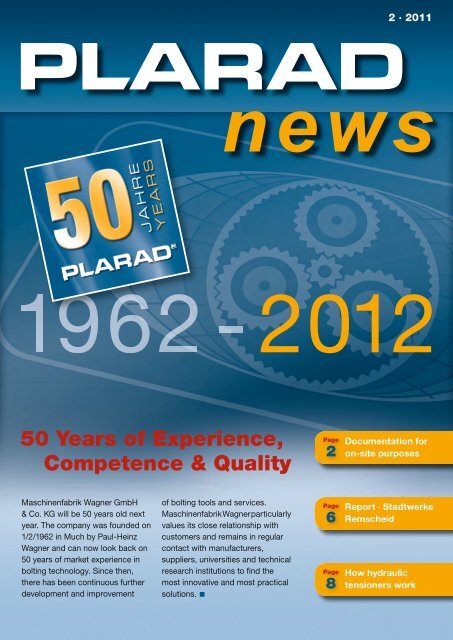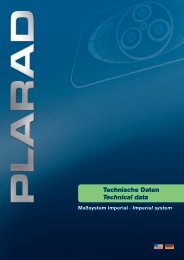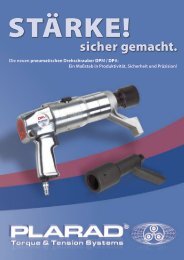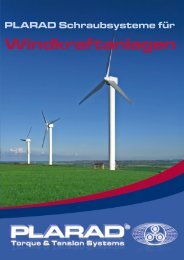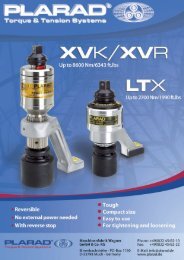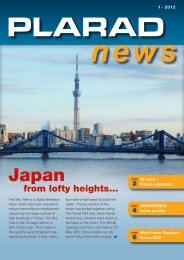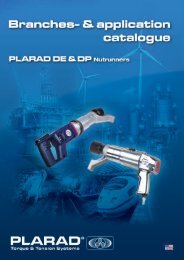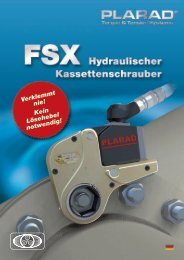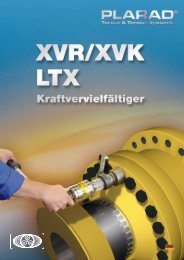Create successful ePaper yourself
Turn your PDF publications into a flip-book with our unique Google optimized e-Paper software.
50 Years of Experience,<br />
Competence & Quality<br />
Maschinenfabrik Wagner GmbH<br />
& Co. KG will be 50 years old next<br />
year. The company was founded on<br />
1/2/1962 in Much by Paul-Heinz<br />
Wagner and can now look back on<br />
50 years of market experience in<br />
bolting technology. Since then,<br />
there has been continuous further<br />
development and improvement<br />
2 · 2011<br />
<strong>news</strong><br />
1962 -<br />
2012<br />
of bolting tools and services.<br />
Maschinenfabrik Wagner particularly<br />
values its close relationship with<br />
customers and remains in regular<br />
contact with manufacturers,<br />
suppliers, universities and technical<br />
research institutions to fi nd the<br />
most innovative and most practical<br />
solutions. ■<br />
Page<br />
2<br />
Page<br />
6<br />
Page<br />
8<br />
Documentation for<br />
on-site purposes<br />
Report · Stadtwerke<br />
Remscheid<br />
How hydraulic<br />
tensioners work
Klaus Teske<br />
Many industrial fi rms are engaged in a process<br />
of transformation from their original manual<br />
production to the industrial manufacture of<br />
their machined products.<br />
2<br />
Special<br />
Bolting document<br />
for on-site pu<br />
The comprehensive and complete documentation<br />
of bolted joints plays an ever greater role in this<br />
process – there are even some plants which can be<br />
insured only with documentation of their bolted<br />
joints. Simple options for the documentation of<br />
bolted joints are increasingly important – particularly<br />
if the bolting is carried out on site. Unlike many<br />
competitive products, <strong>Plarad</strong> bolting tools require no<br />
additional sensors for the documentation of bolting<br />
data. Torque values and, if required, rotation angles<br />
are recorded by an internal sensor system in the<br />
hydraulic power pack. The measured values actually<br />
achieved by the bolting are simply archived in the<br />
control unit for documentation purposes. <strong>Plarad</strong><br />
possesses the national and international<br />
property rights to a large number of different processes.<br />
Particularly on wet and dirty sites,<br />
the fact that no additional sensors<br />
are required means an increase in<br />
the safety factor – no sensor to fail<br />
because of a damp, dirty, oxidised<br />
or incorrect plug connections, no<br />
sensor to fall on the fl oor in rough<br />
working conditions and no sensor<br />
to be damaged during transport.<br />
Furthermore the new <strong>Plarad</strong><br />
Control Unit BE X32 functions<br />
completely independently. No<br />
additional PC is required on site,<br />
either for the retrieval of preset<br />
bolting parameters or for the<br />
documentation of the bolting<br />
operations carried out.<br />
The BE is easy to attach to the<br />
power pack and remains<br />
functional even in extreme<br />
weather conditions, as it complies<br />
with Protection Type IP 54.<br />
Here, suitability for the work site
<strong>news</strong><br />
ation<br />
rposes<br />
also means the consideration of<br />
various safety aspects. When the<br />
appropriate confi guration is<br />
chosen by the supervisor, the<br />
worker has to enter his operator<br />
number or his name in the BE<br />
before starting work, so every<br />
bolting process can subsequently<br />
be attributed to the worker<br />
responsible. The bolting tool<br />
connected is automatically<br />
recognised by the power pack and<br />
is correspondingly assigned in the<br />
BE. In this way, the risk of confusion<br />
with other bolting tools is<br />
avoided. Each bolting operation is<br />
then saved directly in the BE and<br />
can be viewed by the operator at<br />
any time. Should a fault occur<br />
during a bolting operation (e.g.<br />
an operating error or a crossed<br />
thread), the operator immediately<br />
receives an error message. The<br />
corresponding data record is saved<br />
on the BE to ensure that defective<br />
bolting is also documented and<br />
appropriate reworking is possible.<br />
The retrieved data is saved in a<br />
tamper-proof database, the results<br />
are therefore protected against<br />
further manipulation that would<br />
infl uence the actual data (results).<br />
If necessary, they can later be exported<br />
into an Excel fi le and remain<br />
available for further processing. ■<br />
+ + + I N T E R N A L + + +<br />
Petra Hemming<br />
Specialists for the US<br />
windpower industry<br />
The “Training of Specialists in the US Windpower Industry” is a<br />
frequently discussed topic. In May 2011, together with its network<br />
partners August Friedberg GmbH and PSA Sicherheitstechnik,<br />
Maschinenfabrik Wagner/PLARAD organised a donation programme<br />
consisting of PLARAD bolting tools, special windpower bolts from<br />
the fi rm Friedberg and a complete PPE safety kit. This donation was<br />
presented with heavy press coverage on the stand of the State of<br />
Maine during the WINDPOWER Trade Fair in Anaheim/USA.<br />
Donations like this often run into the sand, but that did not apply for<br />
the recipients of this action: Northern Maine Community College<br />
(NMCC) in Presque Isle, Maine. In the new semester, 40 students<br />
have signed up for the subject “Technician in the Windpower<br />
Industry” and will receive a solid training here for the next two years.<br />
On the basis of their qualifi cation, the 14 graduates of the last year<br />
are now sought-after specialists and have already found appropriate<br />
jobs in the windpower industry in the USA. The training consists of a<br />
theoretical and a practical section which, among other things,<br />
includes many hours in the workshop and in the simulated wind<br />
turbine tower. Great emphasis is placed on the subject of safety,<br />
both in bolting technology and with regard to safety in the tower.<br />
Because of their high quality and reliability, the products of PLARAD,<br />
PSA and August Friedberg play an important role in the training<br />
programme. ■<br />
3
Preparation of the<br />
supporting crosspiece<br />
for assembly of the<br />
electrical unit.<br />
4<br />
Highlight<br />
Klaus Teske<br />
Offshore<br />
“BARD Offshore 1” is a<br />
windpark under construction<br />
in the North Sea by BARD<br />
Engineering GmbH.<br />
Power from the wind turbines that<br />
were the fi rst to be erected was fed<br />
into the grid for the fi rst time at the<br />
beginning of December 2010. The<br />
fi rm responsible for installation in<br />
the BARD Group, BARD Building,<br />
is pursuing its continuous optimisation<br />
process. Maschinenfabrik<br />
Wagner, with the brand <strong>Plarad</strong>, has<br />
been able to make a contribution<br />
to this process through installation<br />
support. Among other things, this<br />
covered the condition and the<br />
application of PLARAD bolting<br />
tools.<br />
The focus here was on the utilisation<br />
of the obtained fi ndings to<br />
improve bolting results, to shorten<br />
assembly times, to avoid machine<br />
damage and to prevent accidents.<br />
The safety during assembly of the<br />
tower and the nacelle, for example,<br />
was increased by means of<br />
an optimised support, assembly<br />
scrapes on the tower wall were<br />
avoided and the mechanism of<br />
the hydraulic bolting tool was<br />
subjected to less stress.<br />
The fi rm BARD was extremely satisfi<br />
ed with the overall results and with<br />
the optimisation measures. ■
Installation Support<br />
Photo, top: On the jack-up vessel, where the components for<br />
the offshore turbines are assembled, <strong>Plarad</strong> employee<br />
Klaus Teske also trains BARD employees in the use of the<br />
<strong>Plarad</strong> bolting systems.<br />
Klaus Teske<br />
Special support systems<br />
for your bolting tools!<br />
Maschinenfabrik Wagner GmbH & Co. KG develops<br />
individual support systems to meet your requirements.<br />
In addition to changing the nuts, you can also replace<br />
your supports on the same tool.<br />
Your advantages:<br />
· Less strain on the machine mechanism<br />
· Longer tool service life<br />
· More precise bolting bolting results results through through<br />
the minimisation of shear forces<br />
· Greater safety for the workers<br />
<strong>news</strong><br />
The fi rst tower segment is<br />
lowered over the electrical unit.<br />
5
Theo Grütters / Christine Engelsmann<br />
6<br />
Field Report<br />
Tighten and release wit<br />
Report by Ralf König, Master Motor Vehicle Mechanic, from the Bus Workshop<br />
of Stadtwerke Remscheid GmbH.<br />
Ralf König: “For implementation of the Noise<br />
Abatement Ordinance in our bus workshop, the tools<br />
used, especially the pneumatic bolting tools, are<br />
extremely important. Torque values are continually<br />
increasing, so that, when choosing new tools, the noise<br />
emissions, handling and functionality play a major role.<br />
Our local public transport workshops are subject to<br />
constant change, with state-of-the-art vehicle<br />
technology in both the electronic and mechanical<br />
components. This development makes ever greater<br />
demands, not only on our fi tters, but also on the workshop<br />
organisations. Fault diagnosis on the bus takes up<br />
a large part of the workshop capacity, so that<br />
mechanical and electronic repair work almost always<br />
has to be dealt with at the same time. It is therefore<br />
essential to limit the noise from the mechanical work.<br />
As the senior technician responsible for vehicle<br />
engineering, I was forced to plan mechanical work in<br />
such a way that extreme noise nuisance from<br />
pneumatic bolting tools did not become a permanent<br />
stress. In my search for low-noise tools, I came across<br />
the electrically and pneumatically powered bolting tools<br />
from Maschinenfabrik Wagner. When the fi rst contacts<br />
were made with Wagner’s sales department, they were<br />
surprised that a vehicle workshop wanted a demonstration<br />
of their products.<br />
Until then, their only customers had been industrial<br />
fi rms with large machines and fastening elements<br />
(power plants, wind turbines etc.) with extreme sizes<br />
and torque values. A working demonstration in our<br />
workshop was to bring new insights for both parties.<br />
As we all know, the breakaway torques in assembly<br />
work are so high that generally available pneumatic<br />
bolting tools subject the fi tters to high and prolonged<br />
vibration and noise stress. In addition, there was a lack<br />
of innovative tools for tyre fi tting in local public transport<br />
which could make a breakdown assignment safer.
hout stress!<br />
Day of the demonstration:<br />
A bus with hub-centred wheel rims was provided as<br />
the test object. The bus tyres had had an uninterrupted<br />
service life of approx. 46,000 km. The tightening torque<br />
for the wheel nuts was 600 Nm.<br />
The tools provided by Maschinenfabrik Wagner were<br />
one pneumatic and one electrical bolting tool. First, the<br />
breakaway torque of the wheel nuts on the bus was<br />
measured. This torque was > 1000 Nm. It is amazing<br />
how the tightness of wheel nuts develops after running<br />
such a distance. No wonder normal pneumatic bolting<br />
tools have great diffi culty in releasing these nuts.<br />
The engineers at Wagner know the torque developed by<br />
their products, so, fi rst of all, the pneumatic bolting tool<br />
had to show what it was capable of. With a controlled<br />
air pressure of 4.5 bar and with a soft whir, the wheel<br />
nuts came off as if turned by hand. No noise could be<br />
heard and no vibration was felt in the hands and arms<br />
of the fi tter. Tightening the wheel nuts with a torque of<br />
600 Nm was carried out with a controlled air pressure<br />
of 1.9 bar and was even quieter. Wonderful! Peace and<br />
safety at last for both workers and material. Our fi tters<br />
now looked sceptically at the electrical bolting tool. The<br />
level of the rotary force was set on the potentiometer.<br />
A slight anti-clockwise movement with the sound of a<br />
slowly turning drill, and the wheel nuts were loose. We<br />
were amazed. We had never seen wheel nuts unscrewed<br />
so quickly and so easily. And the tightening went just as<br />
smoothly as the loosening. With no exaggeration,<br />
brilliant. That was the solution for us!<br />
We bought one of each bolting tool. In the following<br />
months, individual extensions and accessories were<br />
specially produced for our requirements. Setting values<br />
for a wide range of torques were documented for the<br />
<strong>news</strong><br />
bolting tools. Today, the handling of these bolting tools<br />
during our bus repairs has been perfected. We loosen<br />
and tighten more and more with high torque values.<br />
The handling and effi ciency of these bolting tools have<br />
enormous advantages in practical occupational safety.<br />
The fl exibility of the electrical bolting tool would have<br />
saved us many headaches over the years in the<br />
loosening and tightening of bolted joints. We are<br />
currently planning to fi t an inverter from 24 V to 220 V in<br />
our breakdown truck so that we can use the electrical<br />
bolting tool for fi tting work on the wheels of our vehicles.<br />
Unfortunately, there is also a drawback. These bolting<br />
tools are very costly to procure. But when the frequency<br />
of use and the personal safety benefi ts for our fi tters<br />
are taken into account, their procurement is absolutely<br />
economical in the long term.” ■<br />
For more information, contact:<br />
Ralf König, Master Automotive Technician<br />
r. koenig@stadtwerke-remscheid.de<br />
7
www.plarad.com<br />
?<br />
Do you know ...<br />
... how hydraulic tensioners work?<br />
Its typical characteristics make the tensioners a special bolting tool.<br />
It is very versatile in use. The preloading force can be set exactly.<br />
No torsion forces are generated and different friction conditions have no infl uence.<br />
<strong>Plarad</strong> tensioning cylinders of the latest generation actually reach their full performance<br />
in operation with 800-bar power packs. Pressure multipliers are no longer necessary.<br />
Components of the tensioner Operation<br />
Step 1: The tensioner is placed on the bolt and<br />
Casing cover<br />
the draw nut is screwed on to the bolt thread.<br />
Piston<br />
Oil<br />
pressure<br />
ducts<br />
Step 2: The oil pressure raises the piston,<br />
together with the draw nut. The bolt is stretched<br />
and the nut rises slightly with it, becoming<br />
loose.<br />
Oil<br />
pressure<br />
Step 4: The oil pressure is lowered.<br />
The piston sinks. This relaxes the end of<br />
the bolt. The draw nut can now be easily<br />
unscrewed. The tensile force between the<br />
nut and the bolt head remains in effect.<br />
The bolted joint now has a controlled<br />
preloading.<br />
Draw nut<br />
Lower<br />
casing<br />
The bolt is<br />
stretched.<br />
The nut is<br />
loose.<br />
Step 3: The nut is tightened until it touches the<br />
surface. It has now reached its fi nal position.<br />
The nut does not have to be tightened again.<br />
Only until the<br />
nut touches.<br />
Do not tighten<br />
further.<br />
Maschinenfabrik Wagner GmbH & Co. KG • Birrenbachshöhe • D-53804 Much • Germany<br />
Phone (Germany): (02245) 62 – 0 • Fax (Germany): (02245) 62 – 66 • E-Mail: info@plarad.com<br />
Phone (international): +49 (0)2245 62 – 10 • Fax (international): +49 (0)2245 62 – 22<br />
Internet: http://www.plarad.com • Issue: December 2011 • Responsible for content: Kirstin Wermter • Editing/Collaboration: Christine Engelsmann,<br />
Theo Grütters, Klaus Hamacher, Petra Hemming, Pierre Muller, Lutz Schmidt, Klaus Teske, Kirstin Wermter, Andreas Zimmer • Photography: Christine<br />
Engelsmann, Wayne Kilcollins, Markus Klein, Lutz Schmidt, Klaus Teske<br />
Copyright: Reproduction or copying, even of extracts, only with prior written permission. Rights to modifi cation reserved.<br />
We accept no liability for printing or factual errors. EK 10387 - 152 EN


